- Details
- Hits: 6537
Station: Gladstone, MI
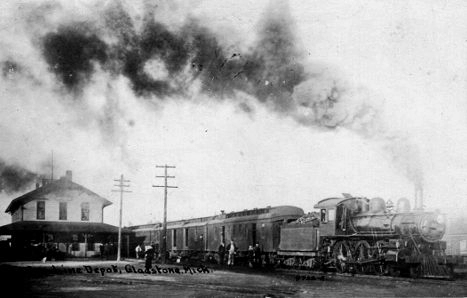
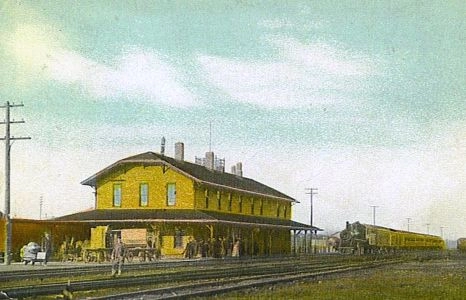
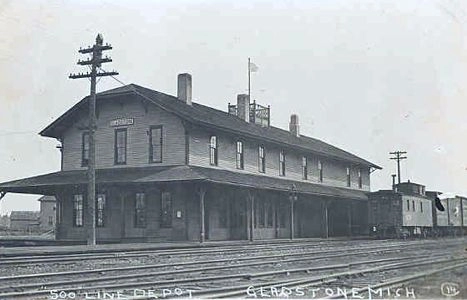
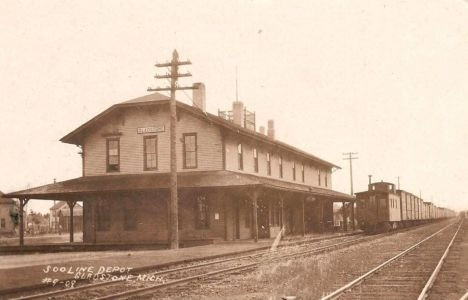 Gladstone is a city in Delta County, about nine miles north of Escanaba. The village was created about 1887. It was originally Minnewaska. It was incorporated as a village in 1887 and a city in 1889. [MPN] The name Gladstone was selected when the town became a city. The name was selected by W.D. Washburn, U.S. senator from Minnesota and President of the Soo Line railroad. The town was named for William Ewart Gladstone, four times prime minister of Great Britain. [EDP-1956-0310]
Gladstone is a city in Delta County, about nine miles north of Escanaba. The village was created about 1887. It was originally Minnewaska. It was incorporated as a village in 1887 and a city in 1889. [MPN] The name Gladstone was selected when the town became a city. The name was selected by W.D. Washburn, U.S. senator from Minnesota and President of the Soo Line railroad. The town was named for William Ewart Gladstone, four times prime minister of Great Britain. [EDP-1956-0310]
Gladstone was a major division point on the Minneapolis, St. Paul & Sault Ste. Marie railroad, commonly known as the Soo Line. The Soo Line changed crews here on their main line route between Minneapolis and the Soo. Today, the CN continues to have a freight yard and minor locomotive service facility here.
Photo info: Top, a 1920's photo of a passenger train picking up passengers at the Soo Line depot. [Mark Worrall Collection], 2nd photo, a postcard view of the depot around the turn of the century. [Alan Loftis Collection]. 3rd and 4th photos, an early photo of the depot with a passing freight train. [Paul Petosky Collection].5th photo, the Soo Line depot at Gladstone, taken in June, 1992. The depot was built around 1887 and razed in the late 1990's. The BN power here is the result of a power trade. [Charlie Whipp]
Notes
The depot was built in 1887 and was torn down in the late 1990's. It was a combination depot handling both passengers and freight. The large 2nd floor would indicate that the second floor was likely used for offices and/or crew rest.
Early on, the railroad also had ore docks here and other industrial facilities on branch lines along the lake shore.
At the Gladstone shops, the railroad had something called a "tall-ho" signal, which was a steam whistle. It was likely used to call back maintenance workers in an emergency such as a derailment. In later years - 1940's - the city borrowed it to use as a fire siren. [EDP-1946-0726]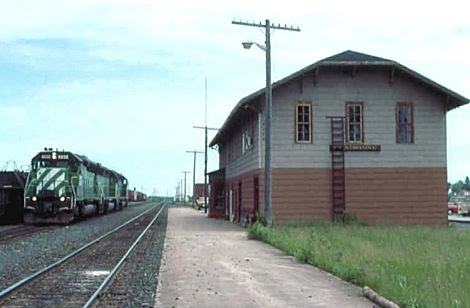
Time Line
1888. Gladstone is a new town only six miles north of Escanaba, on the Little Bay De Noque, an arm of Lake Michigan. It is the principal lake port of the Soo Line. Extensive coal, flour and merchandise docks have already been built at this point, and the present extensive dockage is being added to as rapidly as possible. [DFP-1888-0526]
1892. The Northwestern Cooperage Co. came to the community. About the same time, the Cleveland Cliffs Co., located an iron blast furnace on the shore a short distance north of the town. pEDP-1956-0310]
1895. August 1. The swamps to the west and northwest of Gladstone below the bluff and in the Goodman addition, as well as the marshlands on both sides of the Soo railway are burning furiously. The buildings on the Hammer property, owned by W.D. Washburn Jr. of Minneapolis, have been destroyed. Heavy fires are reported between Sault Ste. Marie and Trout Lake. [LDP-1895-0807]
1907. October. The big water tank at Gladstone suddenly collapses. [DFP-1907-1003]
1909. After being out 16 hours, the jury in the case of S.E. Marcott, of Menominee, against the Soo Line railroad, returned a verdict of $15,000 for the plaintiff, who sued for damages, claiming that a cold he had caught in a sleeper on the road had resulted in pneumonia. [SEB-1898-0604]
1916. April. Two masked robbers entered the Soo Line railroad station's waiting room here last night while it was filled with a score or more of people. They held up the agent and escaped with $700. The people in the waiting room knew nothing of the robbery until after the men had escaped. Not a word was spoken during the robbery. The masked men confronted the agent in his office and one of them placed a revolver against his body. The other robber stood guard at the door watching for trouble from the waiting room. The agent was compelled to open the safe and hand over its contents. By the time the agent could give the alarm, the robbers had disappeared. It was the fourth time within a month that a Soo Line station has been robbed. [PHTH-1914-0408]
1917.The MStP&SSM had operators here on the 1st and 2nd shifts. [TRT]
1931. Purchase of an industrial site in the city of Gladstone was announced by the Ford Motor company through E.G. Kingsford of Iron Mountain, the company's representative in the upper peninsula. Although Mr. Kingsford declined to elaborate, it is understood from reliable sources that the site will be used for a blast furnace, foundry and glass plant. All of the ore used in the furnace will be mined from properties recently purchased in Dickinson County by Ford, including large tracts in both Iron Mountain and Norway. In addition, reports are that the company is planning to establish a fabricating mill in upper Michigan where the foundry castings will be machined. The Gladstone site is about 175 acres in size and nearly all of it was purchased from the Soo Line railroad and George L. Sliming. The Gladstone site provides the company with a deep water frontage on Little Bay de Noc of a mile and a half. Until recently, the property was used by the Soo Line railway for its docks. The location has other advantages of rail connections with the Soo Line as well as the C&NW and the MStP&SSM railways. The latter two roads do not enter Gladstone but will make arrangements to serve the Ford plant. [BHN-1931-0313] Ed. Note: Most of the planned facilities were never built.
1932. Plans of the Cargill Grain company to store again in the large terminal elevator here was made known yesterday when two truckloads of machinery and a crew of men arrived from Green Bay and Minneapolis. The crew started work immediately on getting the elevator in shape and setting up the machinery. The grain will arrive by boat and the machinery will suck the grain from the hold of the boat to the elevator bins. The elevator has been empty for nearly a year, several thousand bushels of grain have been removed shortly after the land on which it stands was transferred to the Ford Motor company by the Soo Line railroad. [EDP-`921-0818]
1933. March. Scrap lumber, worthless for future building use, from the warehouses and dock on the Ford site here which are now being razed, will be given to the city's indigent for fuel purposes. Old residents recalled when package freighters lined the dock three abreast, the Longshoremen's association was in full swing and Gladstone was the scene of great activity. One of the warehouses was built in 1889, within two years of the time the Soo Line was extended into the city. The warehouse had a capacity of 80,000 barrels of flour. Business was so great that the storage capacity of the building proved insufficient and forced the erection of a second warehouse. [EDP-1933-0323]
1935. Conservation Officer Charles Coon has been instrumental in having Gladstone included in the itinerary of the conservation exhibit railroad car, the "Wolverine". The car will arrive in Gladstone on Saturday via the Soo Line railroad and will remain until Monday. The Soo Line is one of several Michigan railroads cooperating in making the tour possible. The car will be parked on a siding off N. Ninth Street. The car is loaded with educational exhibits which include everything from furs to dioramas, similar to displays at the state fair. Specimens of Michigan's fish and game birds are on display as well as hunting, fishing and trapping equipment. Considerable space is devoted to forest fire prevention, detection and control with miniatures of fire fighting equipment. [EDP-1935-0924]
1939. Fire, starting from a painter's blowtorch caused damage to the Soo Line railway depot estimated at between 2,500 and $3,000, the greater part or all of which is covered by insurance. Painters were using blowtorches to remove exterior paint on the north end of the structure which recently has been undergoing extensive modernization and improvement when the blaze caught near a window frame on the second story. [IDG-1939-1019]
1952. Gladstone Welcomes Dionne Quintuplets. Seven world-famous personages visiting Gladstone last evening and a crowd estimated at 800 to 1,000 persons braved near zero weather to accord them a welcome. The famed Dionne quintuplets - Annette, Cecile, Emilie, Marie and Yvonne - and their parents, Mr. and Mrs. Olivia Dionne of Calandar, Ontario. Their special sleeper and a Soo Line business car, which was used as a diner and observation car, were attached to the rear of passenger train No. 7 when it pulled into Gladstone. The girls made their appearance on the rear platform of the observation car and received a welcome on behalf of Gladstone and gifts from the school children of this city. The Quints acknowledged their introductions in English, which had a pronounced charming French accent. Their parents waved as did the affable Father Wells, spiritual advisor of the children.
Each quint received a set of wooden bowls made here by the Shaffstall Industries. The presentations were made by five members of the Gladstone high school senior class. The train came in on time but stopped down near the turntable while locomotives were changed, so it was nearly a half hour after the time of the scheduled arrival when it pulled into the depot. School superintendent Cameron, who with A.C. Peterson, the superintendent of the Gladstone division of the Soo Line railroad, arranged for the appearance of the Quints here. Cameron served as master of ceremonies. The Quints were enroute to St. Paul, where they will be the guests of the president of the Brown and Bigelow corporation, at the St. Paul Winter Carnival. [EDP-1952-0125]
1958. All Saints School is being razed. The building was erected by the Soo Line railroad in 1876 and served as a hotel for many years prior to its use as a school. [EDP-1958-0304]
1965. The Soo Line gives retired locomotive No. 1017 to the City of Gladstone and it is on permanent display, a reminder of the era before diesel power when the iron horse was steam-powered. [EDP-1964-0409] The locomotive hasn't been moved in more than a decade. The locomotive was of the Mikado-type, built for the Soo in 1920 by Dunkirk Iron Works in New Jersey. It weighs 297,000 pounds with 28x30-inch cylinders and 63-inch driving wheels matched four on a side. The engine was as powerful as any locomotive made when it was new. "It used to be a good one," said Harry Ellefson, a former Soo Line fireman. "You could tell the good ones from the bad by the way they ran. Good engines were smoother and seemed to hold the rails better. Some engines also seemed sluggish, but not the 1017", he said. "Yep, it was a good one," agreed Clifford White, a retired Soo employee. "I fired that baby up Pembine Hill many a time. Those were the days before the automatic feeders", White said. "Kept a fellow going pretty good". [EDP-1965-0225]
1965. February. The MPSC will hold a public hearing on a petition of the Soo Line railroad to replace the agent at Hermansville with a traveling agent to be located at Gladstone. The Soo noted that it has seven station employees at Gladstone, which is open to the public 7-days-a-week. Gladstone is equipped with a teletype and flexiwriter and under the plan the agent would be available or on call to serve patrons at the Hermansville station. The road would continue to render all carload and less-than-carload services now available at Hermansville. The Gladstone station would order cars, prepare shipping documents and perform other essential duties in handling Hermansville business. They would also be available 8 or more hours each business day with the railroad paying all toll charges incurred in business calls. A staff member would travel to Hermansville "as often as business conditions require" to handle matters which require an agent's presence. [EDP-1965-0220]
Industry
- Cargill Grain Company
- Cleveland-Cliffs blast furnace
- Marble Division of Bell & Gossett Co. (1960's)
- Northwestern Cooperate
- Shaffstall Industries, wooden ware
Bibliography
The following sources are utilized in this website. [SOURCE-YEAR-MMDD-PG]:
- [AAB| = All Aboard!, by Willis Dunbar, Eerdmans Publishing, Grand Rapids ©1969.
- [AAN] = Alpena Argus newspaper.
- [AARQJ] = American Association of Railroads Quiz Jr. pamphlet. © 1956
- [AATHA] = Ann Arbor Railroad Technical and Historical Association newsletter "The Double A"
- [AB] = Information provided at Michigan History Conference from Andrew Bailey, Port Huron, MI

